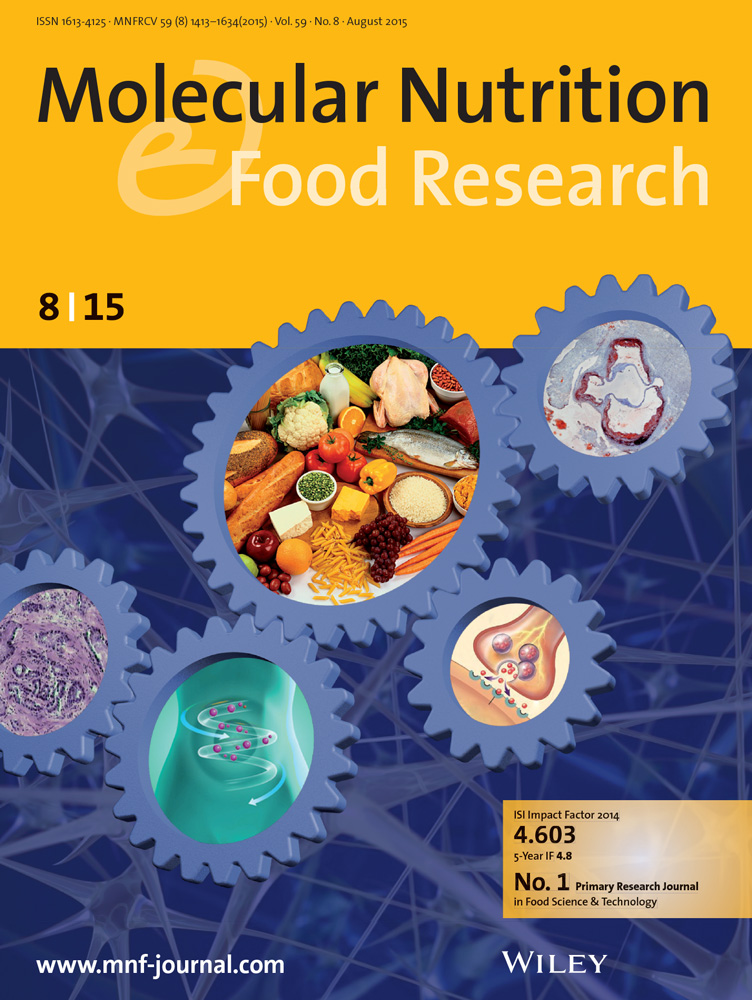坚持EAT - Lancet饮食、基因预测肠道丁酸盐和心血管代谢多病发生风险的前瞻性分析
IF 4.2
2区 农林科学
Q1 FOOD SCIENCE & TECHNOLOGY
引用次数: 0
摘要
我们的研究旨在探讨EAT - Lancet饮食与心血管代谢多病(CMM)风险之间的相关性以及肠道丁酸盐在这一关系中的潜在作用。我们的研究纳入了136,910名英国生物银行参与者,他们在招募时至少完成了一份经过验证的24小时在线饮食回忆问卷,并且最多患有一种心脏代谢疾病。EAT - Lancet饮食指数从0到42,用于将依从性分为四分位数:Q1: <;19, Q2: 19 - 22, Q3: 22-25和Q4:≥25分。采用COX比例风险模型计算风险比(hr)及其相应的95%置信区间(ci)。《EAT - Lancet》与CMM风险呈负相关(HR: 0.95;95% CI: 0.91-0.99),具有显著的线性趋势(p = 0.021)。在那些基因预测肠道丁酸盐水平较低的人群中,发现EAT - Lancet饮食与CMM之间的关系更为明显。联合分析显示,具有高基因预测肠道丁酸盐和高饮食-柳叶刀依从性的患者CMM风险最低(HR: 0.82, 95% CI: 0.69-0.96)。较高的EAT - Lancet饮食依从性与较低的CMM发生风险相关,在遗传预测肠道丁酸盐水平较低的个体中观察到更强的保护作用。本文章由计算机程序翻译,如有差异,请以英文原文为准。
Adherence to the EAT‐Lancet Diet, Genetically Predicted Gut Butyrate and the Risk of Incident Cardiometabolic Multimorbidity: A Prospective Analysis
Our study aimed to explore the correlation between the EAT‐Lancet diet and cardiometabolic multimorbidity (CMM) risk and the potential role of gut butyrate in this relationship. Our study encompassed 136,910 UK Biobank participants who had completed at least one validated 24‐h online dietary recall questionnaire and had at most one cardiometabolic disease at recruitment. The EAT‐Lancet diet index, scaled from 0 to 42, was used to categorize adherence into quartiles: Q1: <19, Q2: 19–22, Q3: 22–25, and Q4: ≥25 points. We employed COX proportional hazard models to calculate hazard ratios (HRs) and their corresponding 95% confidence intervals (CIs). An inverse association was observed between the EAT‐Lancet and CMM risk (HR: 0.95; 95% CI: 0.91–0.99), with a significant linear trend (p for trend = 0.021). A more pronounced relationship between the EAT‐Lancet diet and CMM was found in those with lower genetically predicted gut butyrate levels. Joint analysis showed that those with high genetically predicted gut butyrate and high EAT‐Lancet adherence had the lowest CMM risk (HR: 0.82, 95% CI: 0.69–0.96). Higher adherence to the EAT‐Lancet diet was associated with a lower risk of incident CMM, with a stronger protective effect observed among individuals with lower genetically predicted gut butyrate levels.
求助全文
通过发布文献求助,成功后即可免费获取论文全文。
去求助
来源期刊

Molecular Nutrition & Food Research
工程技术-食品科技
CiteScore
8.70
自引率
1.90%
发文量
250
审稿时长
1.7 months
期刊介绍:
Molecular Nutrition & Food Research is a primary research journal devoted to health, safety and all aspects of molecular nutrition such as nutritional biochemistry, nutrigenomics and metabolomics aiming to link the information arising from related disciplines:
Bioactivity: Nutritional and medical effects of food constituents including bioavailability and kinetics.
Immunology: Understanding the interactions of food and the immune system.
Microbiology: Food spoilage, food pathogens, chemical and physical approaches of fermented foods and novel microbial processes.
Chemistry: Isolation and analysis of bioactive food ingredients while considering environmental aspects.
 求助内容:
求助内容: 应助结果提醒方式:
应助结果提醒方式:


